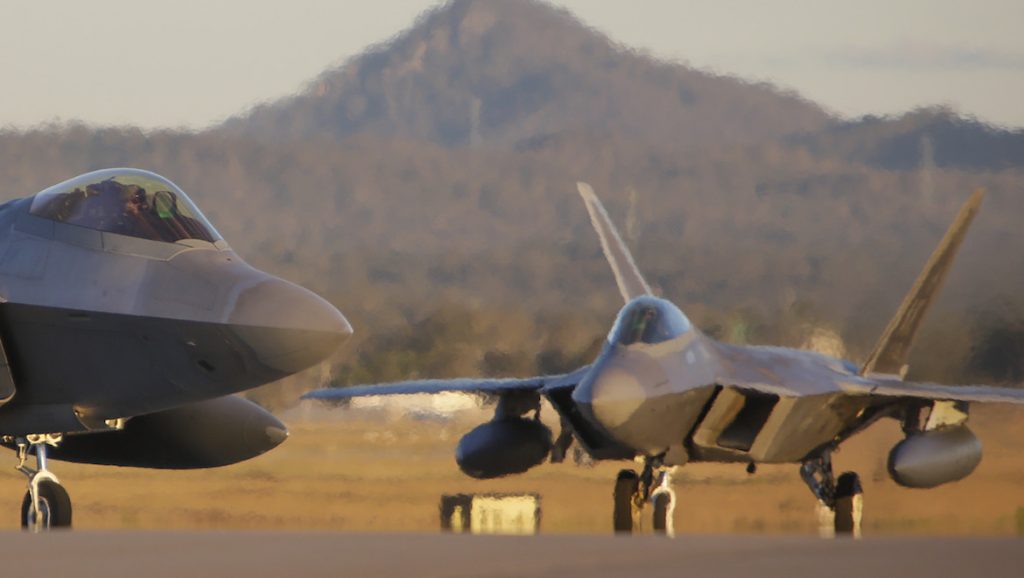
The US Air Force took another meaningful step forwards in its ‘joint force’ initiatives with various fifth-generation aircraft successfully pooling operational data for the first time.
The US Air Force pursuit of the ‘joint force’ saw another successful step forward when fifth-generation aircraft overcame long-standing connectivity limitations, in order to share actionable operational data in their native secure digital “languages” with and through multiple sources for the first time.
This test was the latest demonstration of the transformative warfighting impact of the open architecture underpinning the Advanced Battle Management System (ABMS).
The joint effort included a Marine Corps F-35B variant and the Air Force F-22 Raptor and F-35A Lightning II variant flying with an attritableONE XQ-58A Valkyrie for the first time. The primary tests took place at Yuma Proving Ground, Arizona, with preparatory tests at Nellis Air Force Base, Nevada.
Lieutenant Colonel Kate Stowe, gatewayONE program manager at the Air Force Lifecycle Management Center, set out with 18 test objectives and successfully achieved nine.
“Testing is all about pushing the limits of what’s possible, finding out where the toughest challenges are, and adapting creative solutions to overcoming difficult problem sets,” Lt Col Stowe explained.
Fifth-generation fighters are typically limited to communicating with each other and to command and control centres via legacy tactical data connections, not in their native, but incompatible digital “languages” – Multifunctional Advanced Data Link for F-35 and Intra-Flight Data Link for the F-22.
Lt Col Stowe added, “The real win of the day was seeing the gatewayONE establish a secure two-way translational data path across multiple platforms and multiple domains. That’s the stuff ABMS is all about.”
Not only can gatewayONE translate between those formats, in this test it moved data that is normally relegated to an operations centre or tactical ground node, directly pushing it into the cockpit at the edge of the multi-domain battlespace for the first time.
Additionally, the test pushed the position data of each platform outside of the aircraft’s close-proximity formation through gatewayONE, which enables battle managers on the ground or in the air to better orchestrate operations.
The gatewayONE payload also passed tracks or cues from ground operators to both fighters and passed a cue from the F-35A to the F-22 for the first time.
These bi-directional communications pathways occurred in the platforms’ native digital “languages” and the data was displayed through the aircrafts’ organic systems.
Lieutenant Colonel Eric Wright, a 59th Test and Evaluation Squadron F-35 pilot, explained, “The gatewayONE payload really showed what’s possible and helped us take a big step towards achieving (Joint All-Domain Command and Control).
“This critical capability provides additional connections between our advanced fighters and other forces and battle managers across all domains. The future is promising, and gatewayONE will allow the F-22 and F-35 to connect to and feed data sources they’ve never before accessed. Those future connections will bring additional battlefield awareness into the cockpit and enable integrated fires across US forces.”
Additional successful tests during the week included establishing a communications pathway between the KC-46 Pegasus tanker and a ground node using commercial internet routing standards over the Tactical Targeting Network Technology waveform and the F-35B sending full-motion video to a ground controller.
Preston Dunlap, Air and Space Force’s chief architect, expanded on the comments from his uniformed colleagues, stating, “If fifth-generation platforms are going to be quarterbacks of a joint-penetrating team, we have to be able to communicate with those quarterbacks in an operationally relevant manner and enable data sharing between them, to them, and from them. For years people said it couldn’t be done. Today the team turned another page toward making the impossible possible.”
The December 9 flight test included the attritableONE platform, also known as the XQ-58 Valkyrie, a lower-cost, unmanned, aerial vehicle. The rocket-launched Valkyrie successfully conducted a semi-autonomous flight alongside the F-22 and F-35s for the first time.
The gatewayONE payload was integrated into the Valkyrie for its maiden voyage with the fifth-generation fighters to conduct an initial test of gateway capabilities from an attritable platform; however, shortly after take-off, the communications payloads lost connectivity and those test objectives were unable to be accomplished.
The acquisition team – comprised of Air Force Research Laboratory and Air Force Life Cycle Management Center personnel working in conjunction with Eglin Air Force Base, Florida’s 46th Test Squadron – came together to make this test a success and empower the platforms involved with capability desired by the warfighter and operator.
This integrated test follows a series of gatewayONE ground tests that began during the inaugural Department of the Air Force architecture on-ramp last year in December.
ABMS is the Air Force and Space Force’s priority program to develop the military’s first internet of things and is the services’ primary contribution to Joint All-Domain Command and Control, a Defense Department-led effort to securely connect all elements of the US military – every sensor and shooter – across land, air, sea, space and cyber space.
Written by Stephen Kuper.












